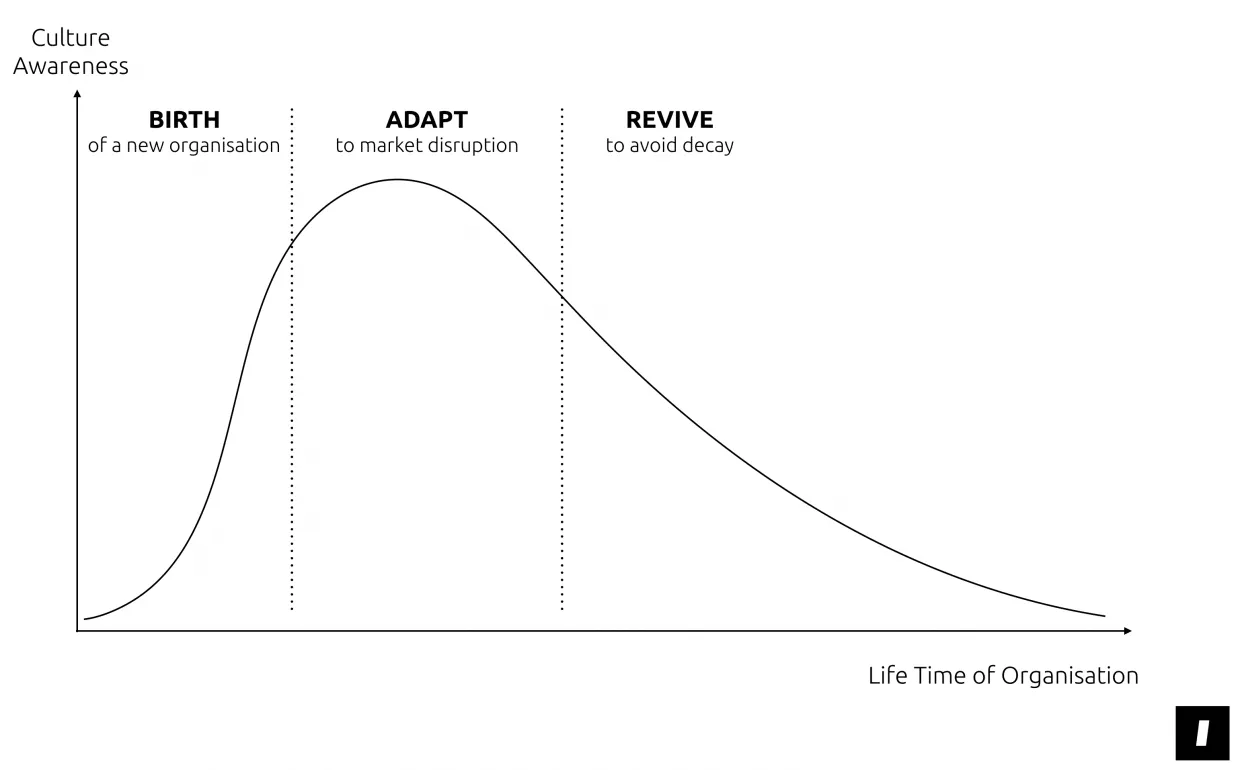The main reason why a corporate culture change fails is the lack of awareness of what the specific culture of the company is. Although it can be observed via the behaviours of employees, leaders are often blind to it until something unexpected and critical for the organisation happens. As it was the case for Uber and United Airlines. But waiting for such a wake-up call might be lethal as the company may not be able to readjust the culture in time and recover from the public blow.
Furthermore, to shift a corporate culture requires an understanding of where the company is in its life cycle. Moving the corporate culture of a young fast growing Uber is not the same as renewing an historic 100-year-old United Airlines. Here are three scenarios of corporate culture change:
- Birthing of a new fast growing organisation;
- Adapting corporate culture to market disruption for a well-established company;
- Reviving an old company culture to avoid decay.

For all three scenarios, we need to use the full-stack approach (DNA, values, vision, and behaviours), and as the corporate culture awareness varies at each life-cycle stage, we need to use more specific tools. Here are the scenarios and some hints on how to approach corporate culture change.
Birth of a new organisation
While the focus of efforts is on succeeding fast, leaders may not be aware enough of the new organisation’s DNA, and first employees are hence the culture creators. This may end up in a confusing melting pot of values and not well-defined norms. The small size of the organisation may allow for fast mutual adjustments at first, but with growth comes more confusion and loss of focus. Internal conflicts emerge as new members of top management team join. Turnover of staff starts to increase as people are not clear on what the organisation is and how they fit in. Charismatic leadership may have worked very well at the beginning but with growth, attachment to one person stops and collective meaning is not dependant on one person anymore.
The key is to clearly define and share the corporate culture fundamentals which will support the founders’ vision, build the brand image and guide the creation of norms.
” …Employers want to drive culture, but employees are the ones who are actually going to build it. “Sean STORIN
One of the consequences of the full-stack approach is to attract the “right” talents. To support the company growth and ensure that the corporate culture will stay coherent, it is crucial to hire for culture fitness. So clear guidelines for recruiters (whether internal or external) include not only the competences the company needs but also the values the organisation is carrying. An authentic communication about the employer brand will help the “right” candidates recognise themselves and apply.
“The culture that Uber’s wanted to build is not one that’s designed to be inclusive and equitable”Joelle EMERSON
Uber’s recruitment guidelines and highly performance-focused management were very coherent with its fast growth but not with a sustainable long term strategy. Uber’s executive team lacked the awareness of the medium to long term effects of such a corporate culture: bad employer brand, loss of talents (employee burn out and harassment), lack of market-reflecting diversity, and no trust and collaboration. As we have seen, it worked for a while and allowed the fantastic growth that Uber showed, but now the internal workings start to show and are damaging the brand and its future. Drastic changes are necessary: a tough job for Frances Frei from Harvard Business School.
Adapt to market disruption
Often at the peak of cultural awareness, with a strong attachment to its own identity, an organisation’s serenity is being disrupted by markets evolution. The new entrants and startups are showing dramatically different approaches to the historical market leaders. The leaders might choose to stay blind to these changes and remain stuck to their own way. Rigidity here being their downfall. The difficulty is to let go (in part) of the corporate culture they have built, nurtured and polished for so long. The corporate culture is so present now, they are so attached to it that changing it feels like a dismemberment. That’s painful. It might be hard to evaluate if that pain is worth it. Would going through corporate culture evolution really help the company stay a leader on those markets, create new opportunities of business development and sustain the long-term vision? Like human beings, organisations are reluctant to go through pain. And change is painful, it requires effort, persistence, endurance, discipline… It’s like going to the gym. Need I say more.
The trick here is to use the strength of the organisation’s DNA, avoiding going counter-nature, and adapting the culture in an intelligent way, with full awareness of environment change. It means adapting mainly its vision and behaviours (norms and processes) and sometimes its values. For visionary companies, this shift can be smooth as it may be part of they DNA to evolve fast, for others it may come as a shock and feel painful. The more people confuse DNA and culture, the more there is resistance to adapt, as nobody wants to change their identity.
In this case, one of the elements of the full-stack approach to corporate culture change is to “weaponize and engage wide”. For example, with one of my clients, the executive team wants to encourage entrepreneurial thinking for their engineer, process-driven managers. Just telling them the famous Facebook motto “move fast, break things” is not going to help them much. Training, coaching and mentoring are supporting them to acquire the mindset and tools to think and act differently. The notions of fast-cycle, testing early, experimenting with their teams can be implanted during training, then supported by coaching and guided by an entrepreneurial mentor. Apart from this external support, managers are supported from within by being given means to experiment (people, resources, permission). Many businesses are going through this transition at the moment, but not often with a full-stack approach which results in a small but not very successful internal incubator, some impactless fun trainings, or overburdened and confused managers. Try to be innovative when the performance -and not learning – KPIs are driving everything.
Revive to avoid decay
In older companies, the corporate culture starts to decay. People go with the flow and repeat traditions as automats. Their DNA is a distant memory, and their culture some old meaningless rituals. Employees feel stuck with the pressure of history, and grandma’s success recipes. They do not wish to betray the memory and do not know how to keep it alive and regenerate it for a new age. Leaders may make decisions based on trends (going customer centric), hence risking to make it impossible for employees to follow (because they are process-driven). Managers may feel a lack of autonomy and the fear of taking risks and innovating. They are often dependent on the internal gurus, keepers of traditions and of the organisation’s spirit.
The key for an older company is to find its spirit again (DNA) to infuse it throughout the company, dust off the culture to give it its full power again.
One of the fun aspects of the full-stack approach is to celebrate the organisation’s DNA and its core values. Retelling the success stories helps to rediscover its spirit. The subtle trick here is to ensure that the focus of these stories is not the old rituals (“what we did then” “we always did it that way”), but the underlying reasons and values that drove the past successful behaviours. Then employees are encouraged to infuse that spirit in what they do and what they could do. Also recognizing how doing things differently can still carry the same spirit.
Looking at United Airlines history, you can see that it is a service to the people: helping Americans communicate (airmail in early days), supporting war efforts during WWII, moving people and material throughout the country easily, and improving flight conditions so that “You’re not just flying, you’re flying the Friendly Skies”. Had that spirit of “friendly flight” been truly embodied by United employees, the latest scandal would not have happened.
In conclusion…
Designing a corporate culture change requires not only a full-stack approach to ensure its efficacy but also an adaptation to the organisation’s history and genetics to stay meaningful. No culture is perfect for success, but we can drive it to be alive, cohesive and supportive of success.


